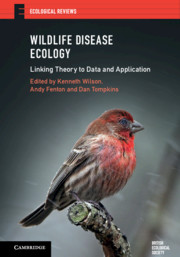Book contents
- Wildlife Disease Ecology
- Ecological Reviews
- Wildlife Disease Ecology
- Copyright page
- Contents
- Contributors
- Preface: Wildlife Disease Ecology
- Glossary of Terms
- Part I Understanding within-host processes
- Part II Understanding between-host processes
- Chapter Eight Using insect baculoviruses to understand how population structure affects disease spread
- Chapter Nine Infection and invasion: study cases from aquatic communities
- Chapter Ten Parasite-mediated selection in red grouse – consequences for population dynamics and mate choice
- Chapter Eleven Emergence, transmission and evolution of an uncommon enemy: Tasmanian devil facial tumour disease
- Chapter Twelve Bovine tuberculosis in badgers: sociality, infection and demography in a social mammal
- Chapter Thirteen Mycoplasma ovipneumoniae in bighorn sheep: from exploration to action
- Chapter Fourteen Manipulating parasites in an Arctic herbivore: gastrointestinal nematodes and the population regulation of Svalbard reindeer
- Part III Understanding wildlife disease ecology at the community and landscape level
- Index
- Plate Section (PDF Only)
- References
Chapter Eleven - Emergence, transmission and evolution of an uncommon enemy: Tasmanian devil facial tumour disease
from Part II - Understanding between-host processes
Published online by Cambridge University Press: 28 October 2019
- Wildlife Disease Ecology
- Ecological Reviews
- Wildlife Disease Ecology
- Copyright page
- Contents
- Contributors
- Preface: Wildlife Disease Ecology
- Glossary of Terms
- Part I Understanding within-host processes
- Part II Understanding between-host processes
- Chapter Eight Using insect baculoviruses to understand how population structure affects disease spread
- Chapter Nine Infection and invasion: study cases from aquatic communities
- Chapter Ten Parasite-mediated selection in red grouse – consequences for population dynamics and mate choice
- Chapter Eleven Emergence, transmission and evolution of an uncommon enemy: Tasmanian devil facial tumour disease
- Chapter Twelve Bovine tuberculosis in badgers: sociality, infection and demography in a social mammal
- Chapter Thirteen Mycoplasma ovipneumoniae in bighorn sheep: from exploration to action
- Chapter Fourteen Manipulating parasites in an Arctic herbivore: gastrointestinal nematodes and the population regulation of Svalbard reindeer
- Part III Understanding wildlife disease ecology at the community and landscape level
- Index
- Plate Section (PDF Only)
- References
Summary
Since its emergence, devil facial tumour disease (DFTD) has spread throughout most of the geographic range of the Tasmanian devil, causing >90% local population decline, >80% overall decline and cascading effects on the ecosystem. We developed a decision tree to guide research and management of this cancer. The devil–DFTD system gives an opportunity to study a wildlife disease in all stages of existence across the entire geographic range of a natural host. Despite predictions of extinction, devils persist. State–space models show that individuals with higher fitness (the larger, more dominant individuals responsible for most of the biting) are more likely to become infected themselves. Individual-based models in which demographic parameters depend on the size of the tumours carried by individual hosts show that DFTD epidemics operate on a much slower timescale than those of viral or bacterial diseases. Following an initial epidemic peak, the consequences for a general epidemic may be coexistence, even in the absence of evolutionary changes in either host or pathogen. Multiple lines of evidence show that Tasmanian devils are evolving in response to DFTD. Conservation efforts are now shifting from managing for extinction to managing for persistence.
Keywords
- Type
- Chapter
- Information
- Wildlife Disease EcologyLinking Theory to Data and Application, pp. 321 - 341Publisher: Cambridge University PressPrint publication year: 2019
References
- 2
- Cited by



